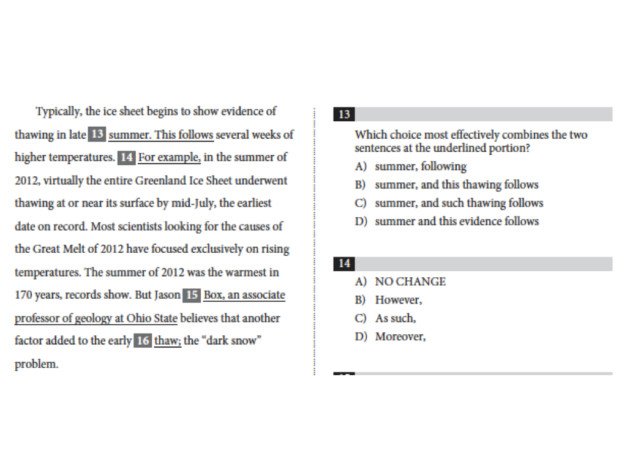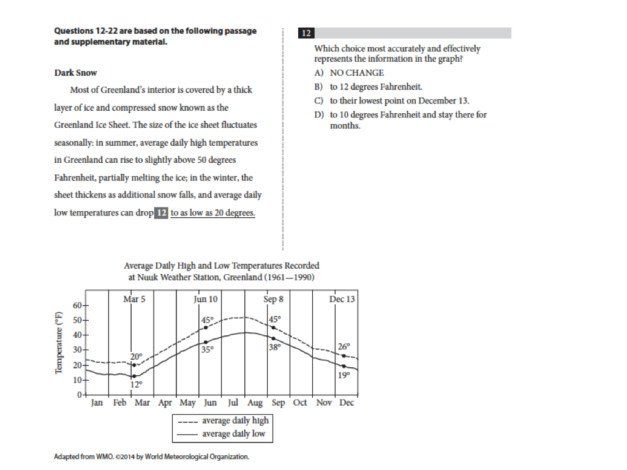Ultimate Guide to the New SAT Writing and Language Test

Originally developed over a century ago, the SAT is designed to measure career and college readiness. It has been adapted over the years to reflect current standards and emphases in American education, with its most recent change taking place in 2016.
Anytime something as significant as the SAT changes, a small adjustment period is required. Students, parents, teachers, and test prep experts have stepped back, evaluated the new test format and content, and fine-tuned their preparation methods to meet the standards of an evolving assessment. To learn more about the most significant changes on the SAT, read CollegeVine’s A Guide to the New SAT or review Khan Academy’s video overview of Content Changes to the New SAT.
Over the past six months, the SAT experts here at CollegeVine have been analyzing the new test and evaluating materials and data from the College Board, Khan Academy, and private sources. We’ve dug deep into the new SAT, and now we’re ready to share some of our findings with you here.
The SAT Writing and Language Test is one of two components of the Evidence-Based Reading and Writing portion of your SAT. This section replaces the Critical Reading Test and Writing Test from the previous iteration of the SAT. The new Writing and Language test takes place at a much quicker pace than the previous test’s version, with just 35 minutes allowed to complete 44 questions. The new test also places a greater emphasis on the meaning of words in extended contexts and on how word choice shapes the meaning, tone, and impact of a written piece.
To learn more, read on for the CollegeVine ultimate guide to the new SAT Writing and Language Test.
What is the format of the new SAT Writing and Language Test?
The new SAT Writing and Language Test consists of 44 multiple-choice questions that you’ll need to answer in 35 minutes. This is a big change from the prior version of the SAT Writing test, which consisted of 49 questions but allowed a full 60 minutes to complete them.
All of the questions on the new Writing and Language Test are based on written passages. There are four written passages on the test, each between 400-450 words. Some passages are accompanied by informational graphics, like tables, graphs, or charts, but no math will be required on this portion of the test. The passages on the exam will consist of one non-fiction narrative passage, one to two informative/explanatory texts, and one to two argumentative or persuasive pieces.
The passages on the Writing and Language Test will be presented alongside the associated questions, with the passages presented in the left-hand column and the questions presented in the right-hand column. Question numbers will be embedded in the text of the passage as well to help you locate the associated text. There may also be other forms of notation, including underlining, which will help to guide you to what part of the passage is being tested at any given point. Some questions may also ask about the passage as a whole.
Unlike on the new SAT Reading Test, passages used on the Writing and Language Test are always developed specifically for use on the test.
What does the new SAT assess?
The new SAT Writing and Language Test assesses your ability to do the three things that you should already be doing and will continue to do in college when you write and edit:
- Read and interpret
- Find mistakes and weaknesses
- Fix or improve them
More specifically, you will be expected to demonstrate your knowledge and ability in the following content areas:
Command of Evidence: Demonstrating your command of evidence requires you to show your ability to improve the way that passages develop information. You’ll demonstrate that you know how to build an argument, add relevant supporting details, and sharpen evidence that has already been used.
Words in Context: These questions will ask you to improve word choice, choose the best words based on greater context, or use word choice to make a passage more precise or concise. You may also be asked to consider word choice as it relates to syntax, style, or tone.
Analysis in History/Social Studies and in Science: These questions will ask you to critically read informational texts and make editorial decisions to improve them. You might need to clarify sequence, improve precision of data reported, or better relate a passage to an associated informational graphic.
Expression of Ideas: The questions assessing your expression of ideas will challenge you to think about a passage’s overall organization, impact, and flow. You will be tasked with changing words or structure to improve the strength of the passage and how its sentences and paragraphs work together.
Standard English Conventions: Finally, a large part of the test will assess your knowledge of Standard English Conventions. This includes sentence structure, usage, and punctuation. You will need to change words, clauses, sentences and punctuation to ensure that they conform to common grammar rules. You’ll also edit for verb tense, parallel sentence construction, subject-verb agreement, and comma use.
As you study the content areas above, keep in mind how heavily each is weighted. You can expect to see 24 questions assessing your expression of ideas, 20 questions assessing your grasp of Standard English Conventions, and eight questions each assessing your command of evidence and use of words in context. Some questions will assess more than one content area at a time.
To see how the new SAT Writing and Language content compares to the content on the PSAT, see the Writing and Language content alignment chart.
What are some key strategies for the new SAT?
1. Know where to look in the text to answer your question
This is the easiest way of making sure that you maximize your efficiency on the test and it’s fairly simple to master. All questions will be printed and numbered in the right-hand column of the test alongside the passage, which is printed in the left-hand column.
For most questions referring to a specific place in the text, the number will also appear in the passage itself, embedded in the text to help you locate it. For example, consider the excerpt below taken from an official College Board SAT Writing and Language practice exam.
Note that in this case, the portion of text to which question number 13 refers is highlighted by the preceding 13 in the passage itself, with the subsequent underlined selection clarifying exactly which words you should consider modifying for the question (If you’re wondering, the correct answer is “A,” because it most concisely combines the two sentences while maintaining their original meaning).
Question 14 in the example above is slightly different. It does not ask an explicit question but instead simply embeds the question number before the associated, underlined text. Although it is not explicitly stated as the question, the answer choices are possible replacements for the underlined text.
Your job on a question such as this is to choose the best alternate-word choice for this text. If you believe that the best word choice is already printed in the passage, you would choose the answer “A) NO CHANGE.” (If you’re following along, the correct answer to question 14 is “B,” because it contains the conjunctive adverb “however,” which most accurately indicates the contrasting relationship between the two sentences.)
By knowing how to interpret the questions and where to find the text they refer to, you will be one step ahead on test day. Just make sure to practice using official practice tests so that you can ensure the directions given on your practice test are exactly the same as those given on the real SAT.
2. Know the purpose of the passage you’re reading
There are many different styles of writing and the stylistic choices made by an author will always depend on the purpose of the written piece. For example, articles that are written to teach or inform will not include opinions and will only rarely include vague word choices such as perhaps or mostly. On the other hand, persuasive essays will include stronger word choices to build strong, convincing arguments. Personal narratives will often include words to elicit emotion.
To be an effective editor, you will need to identify the purpose of the passage you’re reading at the very beginning. This knowledge should help to guide you as you progress through the editing process. More formal passages, such as scientific articles written to inform, will require more formal word choices and style, while first-person narratives will often be more colloquial in nature. When selecting an alternate word choice or phrase, read the sentence in context with the sentence before and after to make sure that it fits with the overall tone.
3. Know how to interpret informational graphics
This is another fairly simple way to ensure that you don’t miss points for something you could have mastered before the test. The informational graphics included on the SAT Writing and Language Test will always be fairly straightforward in that they will never test your math skills. Instead, they will assess your ability to make sense of information presented graphically.
These informational graphics could be graphs, tables, figures, or maps. Familiarize yourself with these by finding them in context in your school textbooks, magazines and newspapers, and of course practice SAT exams. The example below shows a graph included in the Writing and Language portion of an official College Board practice test.
Note that the graph itself is not complex. The variables and axes are clearly labeled, and the title gives a very specific indication of the graph’s content. The answer choices simply propose some common errors that you might make in interpreting the graph.
To answer this question, first look in the passage to determine what it’s asking. In this case, the question is essentially asking you to identify the lowest that the average daily low temperature falls. By using the key, you can see that the solid line, not the dotted line, denotes average daily lows, so immediately you can discard any values derived from the average daily high-dotted line. Of the remaining options, the only one that includes accurate data from the graph is “B) to 12 degrees Fahrenheit,” which is the correct answer.
4. Answer questions as you’re reading
This is primarily a time-saving tip, so if you are a particularly fast reader or have found that you work better when reading the piece all the way through and have no problem with the time constraints, then feel free to use another method that works best for you. However, our experience is that the SAT Writing and Language Test is a particularly time-crunched one. Remember, you have only 35 minutes to read four passages and answer 44 related questions.
Luckily, the passages and questions are designed to make it easy to answer questions as you read. Questions are sequenced in order of appearance and the questions and associated passage text are always printed alongside, even when it means breaking up the passage between multiple pages. Any questions that relate to the passage as a whole will come at the end of the passage.
As such, the side-by-side format is extremely conducive to answering questions as you come across them. Reading the entire passage, split across multiple pages, and then going back to answer questions and re-read specific text for each one is inefficient and could cost you precious time better spent on checking your work.
5. Brush up on common grammar rules and English conventions
There are not many content areas on the Evidence-Based Reading and Writing portion of the SAT that benefit from explicit rote memorization, but Standard English Conventions are one of them. This includes things like subject-verb agreement, punctuation, phrase-subject agreement, clauses, and pronouns. Remember, almost half of the questions in this section will test your knowledge of these rules. Basically, you need to become a grammar fiend.
To do this, buy a grammar review book, check out the SAT grammar tutorials on Quizlet, and head over to the grammar review resources on Khan Academy.
6. Practice: read, write, and edit as much as possible
Writing and editing are skills that develop over time with repeated exposure and experience. They are not skills that can be learned in isolation or crammed for the night before the test.
The easiest and best way to build these skills is by starting well ahead of time with lots of practice. The good news is, if you’re in high school, you are probably doing this already. Read, write, and edit as much as possible. Read the newspaper and magazines. Read textbooks. Write for all of your classes, even if only a chapter summary. Edit your own work, edit your friends’ work, edit text you come across on the Internet.
When you receive written work back from your teachers, instead of looking at your grade and then cramming it into your backpack, review each and every edit your teacher made. If there are any that you don’t understand, ask a friend or your teacher to explain them to you. Immerse yourself in reading, writing, and editing so that when you encounter it on the test, it’s already second nature.
Where can I find free study materials?
To kick off your studying, take the CollegeVine free diagnostic SAT with customized score report and action-plan help to get a better idea of where you’re starting from and the direction that your studying should take you.
The College Board Student SAT Study Guide is another great place to start to get an overview of the test and the topics you can expect to find on it. You’ll also see a breakdown of scoring and SAT subscores to help guide your studying.
The College Board also maintains a Daily Practice SAT app that provides daily test questions, answer hints, and answer explanations. Another cool feature is its Scan And Score option, which enables you to use your phone’s camera to scan your practice-test answer sheets and submit them for automatic scoring.
In addition, Khan Academy provides a number of study materials including study tips and video tutorials.
Once you’ve spent some time learning the material, put it to use on some College Board sample questions or a full-length practice test.
Preparing for the SAT? Download our free guide with our top 8 tips for mastering the SAT.
To learn more about the SAT, check out these CollegeVine posts:
Want to know how your SAT score/ACT score impacts your chances of acceptance to your dream schools? Our free Chancing Engine will not only help you predict your odds, but also let you know how you stack up against other applicants, and which aspects of your profile to improve. Sign up for your free CollegeVine account today to gain access to our Chancing Engine and get a jumpstart on your college strategy!




